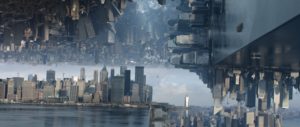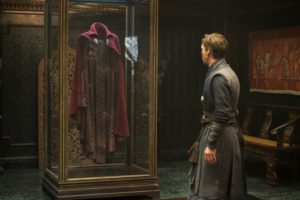
VFX supervisor Stephane Ceretti knows a little about multiple dimensions: From the interweaving timelines of Cloud Atlas, to the “Dark World” in Thor, along with his Oscar-nominated work in Guardians of the Galaxy, he’s helped render the light fantastic, all the way back to a pair of Matrix installments while working for Euro-centered FX shop BUF.
But his latest work, overseeing the transformation of the psychedelic comics art of Steve Ditko to the screen as Doctor Strange — created by Ditko and Stan Lee — joins the Marvel Cinematic Universe, called on nearly all the influences and ideas he’d used before.
As the good Doctor discovers the worlds of magic and mysticism — seeking right-brained solutions after his left-brain world as a surgeon comes literally crashing down after a car wreck — the visuals in the movie run the gamut from the constantly shifting planes of M. C. Escher to the use of fractals, and a major nod to the “infinity trip” in 2001: A Space Odyssey.
Indeed, Ceretti described the work environment he set up with director Scott Derrickson as a “psychedelic campus,” where ideas and techniques could be shared, added and refined as production went along.
Previs shop The Third Floor was used early on, because he notes, that while the storyboards he, Derrickson, and everyone else were coming up with were good, “they were not enough.”
Or rather, they were quickly outstripped as the work became a “kind of puzzle” to fit together sequences and vendors. Ceretti notes that while their time in post was startlingly brief for a production of this magnitude — 6 months — it was made up for with “a lot of time in pre-production.”
That time was spent with the different FX shops, including four key vendors that helped bring the “psychedelic campus” into focus: ILM, Framestore, Method Studios, and Luma Pictures.

ILM, Ceretti says, “is very good at environments,” and so worked on both New York and Hong Kong set pieces, where the forces of light and dark both battle. Luma’s work was “very creative with the dark dimension,” and Framestore focused on astral projection sequences, where the Benedict Cumberbatch’s Doctor would leave his body, as well as animating characters like, well, the good Doctor’s cloak, which “wasn’t such a character initially,” Ceretti recounts. The garment later became, in his analogy, like a cowboy’s faithful horse. Though, he adds with a laugh, in this case “the cloak is more riding him.”
Of course, he adds, the “cloak of levitation” is also “a little like a magic carpet, too.”
As for Method Studios, their L.A. branch did most of what Ceretti calls “the Magical Mystery Tour” — i.e., the aforementioned 2001-like “infinity trip” that Stephen Strange goes on as his tutelage by the Ancient One, played by Tilda Swinton, leads to nearly every “door of perception” — as Huxley would say (and who was also an influence on those “Mystery Touring” Beatles, as well) — being flung wide open all at once.
Ceretti describes the film, and its numerous key set pieces, as using “a mixture of things,” whether rendering, green screen, practicals, or anything, and everything, else, all of which would “change throughout a sequence.”
“That’s what works,” he says, as far as keeping what are clearly visual effects from looking too “FX-y,” and making the impossible at least seem a bit more “real.”
It also keeps some of the visual magic intact, for one of this year’s biggest mystery tours.





